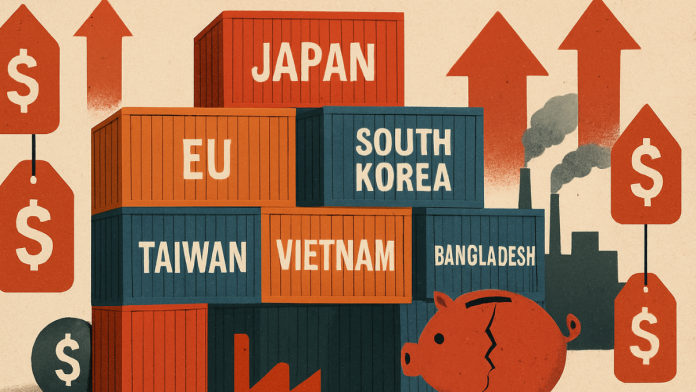The United States economy is starting to feel the squeeze as new import taxes, known as tariffs, began on Thursday. These taxes target goods from over 60 countries, including the European Union, Japan, South Korea, Taiwan, Vietnam, and Bangladesh. Starting just after midnight, products from the EU, Japan, and South Korea now face a 15% tax, while imports from Taiwan, Vietnam, and Bangladesh are hit with a 20% tax. This means everyday items like toys, clothes, and electronics could cost more for American families.
These tariffs follow months of warnings, and their effects are already showing up. Businesses are raising prices, and some are cutting back on what they buy from other countries. Shoppers might soon notice fewer choices or higher prices in stores. The goal of these taxes is to bring more money into the U.S. and boost local manufacturing, but right now, the changes are causing challenges for many.
Higher Costs Hit American Businesses Hard
The new tariffs are making it more expensive for companies to bring in goods from other countries. For example, a store that sells phones made with parts from Asia might now pay 20% more for those parts. This extra cost can force businesses to raise prices or make less money. Some companies are trying to find suppliers in the U.S. or countries with lower taxes, but this isn’t easy or quick.
UN voices concern over US tariffs on India tied to Russian oil trade
Small businesses are especially struggling. They often don’t have the money or connections to switch suppliers fast. Some are even slowing down hiring or letting workers go to save money. For instance, a small factory that makes clothes might produce fewer items because the fabric from overseas now costs more. This can mean fewer jobs for workers in those factories.
The tariffs have also led to a rush of imports before the taxes started. Companies brought in extra goods to avoid the new costs, which has made the U.S. trade deficit—the gap between what the country buys and sells—grow by 38% in the first half of this year compared to 2024. This shows that the tariffs are already shaking things up, but not always in the way that was planned.
Shoppers See Prices Climb for Everyday Goods
American families are starting to feel the tariffs’ impact when they shop. When businesses pay more for imported goods, they often pass those costs to customers. This means things like shoes, toys, or even food might cost more. For example, a backpack that used to cost $30 could now be $36 or more because of the taxes on materials from other countries.
These price hikes can make it harder for families to afford what they need. Parents might spend more on school supplies or clothes for their kids, leaving less money for other things. Since so many products in stores come from other countries, it’s tough for shoppers to avoid these higher prices. Even food like fruits from Mexico or South America could get pricier.
The tariffs affect a wide range of goods, from electronics to clothing to car parts. This makes it challenging for families to stick to their budgets. Some people are already shopping less or looking for cheaper options to cope with the rising costs.
Global Trade Feels the Ripple Effects
The countries hit by these tariffs are reacting. Some, like the European Union, are considering their own taxes on American goods. This could hurt U.S. companies that sell things like cars or food to other countries. For example, an American farmer selling corn to Europe might lose customers if the EU adds taxes on that corn.
India faces an extra 25% tariff because of its oil purchases from Russia, making its total import taxes to the U.S. reach 50%. This affects more than half of India’s exports to America, like clothes and electronics, and could make it harder for Indian businesses to keep their U.S. customers. Switzerland also tried to avoid a 39% tariff on its goods but failed, which could raise prices for things like Swiss watches or medicines.
The tariffs are changing how goods flow in and out of the U.S. While they aim to bring more money and jobs to America, they’re also causing higher prices and trade tensions. The effects are rippling through businesses, shoppers, and global trade partners, with more changes likely to come.


